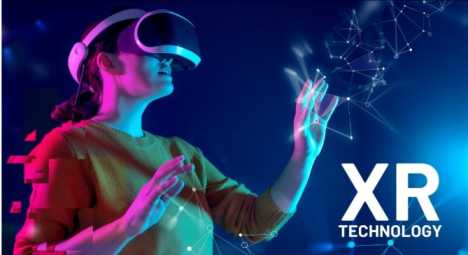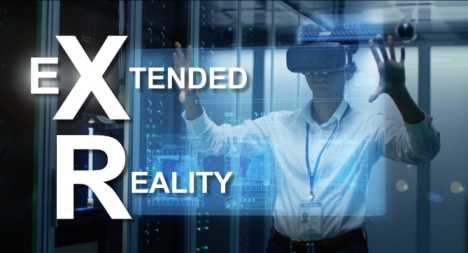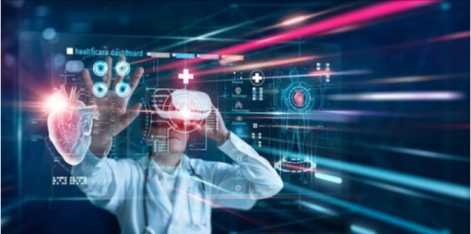
The fusion of the tangible and digital realms through Extended Reality (XR) technologies represents a paradigm shift in how we perceive and interact with the world around us. XR, comprising Virtual Reality (VR), Augmented Reality (AR), and Mixed Reality (MR), is erasing the boundaries between physical and virtual spaces, ushering us into a new era of immersive experiences and interconnected realities. This transformative convergence is not merely a technological advancement but a cultural and societal evolution that is redefining human experiences, from entertainment and education to business and communication. As XR blurs the lines between what is real and what is virtual, it challenges us to rethink our understanding of reality, creativity, and human connection in ways that were once confined to the realm of science fiction.
QualityReality, a division of GameCloud Technologies Pvt Ltd, is at the forefront of pioneering Extended Reality (XR) solutions, aligning closely with the theme of blurring the lines between the real and virtual worlds. Specialising in XR and Metaverse services, our commitment to excellence in this dynamic field resonates with the transformative potential of XR technologies. By offering comprehensive testing and development on XR platforms, we ensure that developers can deliver immersive and seamless experiences that bridge the gap between reality and virtuality. Our dedication to quality testing for XR and Metaverse applications underscores the importance of creating engaging and functional virtual experiences that push the boundaries of innovation and user engagement. Through our expertise and dedication to quality assurance, we play a vital role in shaping the future of XR and its integration into your everyday lives, contributing to the evolution of digital experiences that redefine your perception of reality.
Immersive Experiences Redefining Reality

XR technologies are revolutionising entertainment, education, and training by creating lifelike simulations that engage all senses, transporting users to virtual realms that feel increasingly real. In the entertainment industry, XR stage production is disrupting traditional film and TV show production. XR stages can include virtual and augmented reality tools, allowing for motion tracking, position, and direction tracking, real-time rendering, and other cutting-edge operations. This technology has led to the creation of engaging and interactive experiences for audiences, attracting enthusiasts and improving production quality.
In education, XR is revolutionising the learning experience by introducing immersive experiences, interactive 3D models, and adaptive learning paths. XR technologies such as virtual reality (VR), augmented reality (AR), and mixed reality (MR) extend reality by adding to or simulating the real world through digital materials. VR allows learners to develop skills and encounter true-to-life scenarios without facing real-world risks, while AR utilises interactive or digital elements in a live, real-world environment. Mixed reality combines both AR and VR, blending the physical and digital worlds.
XR training is also transforming employee training and development in various industries, including healthcare, manufacturing, and construction. It offers real-world simulations for hands-on training, improving knowledge retention and engagement. XR allows customers to experience products and services in a virtual environment, providing a safe and accessible way to educate audiences about products and services. Soft skills training, such as emotional intelligence and active listening, can also benefit from XR training, as it offers simulated interactions with virtual characters in digital environments.
How can xr technology be used to enhance employee training?
Extended Reality (XR) technology can significantly enhance employee training by providing immersive and interactive experiences that engage learners and promote knowledge retention. Here are some ways XR can be used to enhance employee training:
- Immersive Learning: XR technologies, such as Virtual Reality (VR) and Augmented Reality (AR), can create lifelike simulations that transport users to virtual realms, making the learning experience more engaging and enjoyable. This immersive nature of XR can increase employee engagement and motivation, leading to better knowledge retention and skill acquisition.
- Realistic Simulations: XR technologies can simulate real-world scenarios, allowing employees to learn and practice skills in a safe and controlled environment. For example, in the food manufacturing industry, XR training can simulate equipment operation, maintenance, and quality control, enabling employees to learn and refine their skills without the risk of damaging expensive machinery or causing food safety issues.
- Remote Learning and Collaboration: XR technologies enable remote learning and collaboration, allowing trainers and trainees to work together in virtual environments regardless of their physical locations. This can be particularly useful in industries where employees need to learn from experienced operators, and it can help reduce the time it takes for new operators to become competent.
- Accessibility and Cost Savings: XR technologies can help companies save money on training equipment and environments. For example, training employees on repairing aircraft engines using virtual copies is more cost-effective than using real engines.
- High Engagement and Knowledge Retention: XR training can be designed to resemble games, making the learning experience more enjoyable and engaging for employees. Additionally, XR training can be enriched with game elements, such as achievement points for correct virtual connections, which can further increase engagement and knowledge retention.
- Analytics and Tracking: XR technologies can be complemented by various sensors that allow for collecting extensive trainee metrics, including behavioural data, heat maps, gesture and eye tracking, voice recognition, and more. These comprehensive systems can help evaluate the efficiency of XR training programs and improve them.

Some specific examples of XR technology being used for training purposes:
- Healthcare: Companies like Osso VR provide VR surgical training for medical professionals, allowing them to practise procedures and protocols without any risk to themselves or others. This immersive simulation helps trainees to improve their skills and confidence before entering a real-life operation theatre.
- Manufacturing: In the manufacturing industry, XR technology is used to provide realistic simulations of machinery operation, safety protocols, and emergency response training. This allows employees to gain hands-on experience in a safe and controlled setting, promoting active participation, knowledge retention, and skill acquisition.
- Aviation: XR technology is used to train employees in the aviation industry by offering realistic simulations of aircraft operation, safety procedures, and emergency response training. This helps employees to learn new skills, practice procedures, and improve performance in a safe and controlled environment.
- Construction: XR technology is used in the construction industry to simulate complex scenarios and high-risk situations, allowing learners to gain hands-on experience in a safe and controlled setting. This enables employees to learn new skills, practice procedures, and improve performance in a safe and controlled environment.
- Virtual Onboarding: Companies like Accenture have implemented immersive virtual onboarding programs, providing new employees with a head-mounted display (HMD) and access to a virtual campus to complete their training. This approach has been shown to increase employee satisfaction, knowledge retention, and overall performance.
- Employee Training for Complex Machinery: XR technology is used to train employees on how to operate and repair complex machinery, such as in the manufacturing industry. Augmented Reality (AR) is particularly effective in this context, as it allows employees to view the workplace or a piece of machinery in real time with superimposed digital training elements.
- Empathy Training: Large-scale companies are using XR technology to provide empathy training for employees, allowing them to practise interactions with customers in an immersive environment. This can help employees who may benefit from practice and repetition before interacting with customers or exploring new job sites.
Ethical Considerations: Examine the ethical implications of the metaverse
The metaverse, a collective virtual shared space, has the potential to revolutionise the way we interact, work, and play. However, it also raises ethical concerns related to privacy, security, and data collection. As users navigate virtual spaces and interact with AI-driven environments, it is essential to examine these ethical implications:
- Privacy: In the metaverse, users may be required to share personal information to participate in various activities. This raises concerns about how this data is collected, stored, and used. It is crucial to establish clear guidelines and regulations for data collection and protection.
- Security: As users interact with AI-driven environments, there is a risk of cyber threats such as hacking, phishing, and identity theft. It is essential to develop robust security measures to protect users and their digital assets.

- Data Collection: The metaverse relies on data collection to provide personalised experiences and improve services. However, this raises concerns about data ownership, control, and potential misuse. It is essential to establish clear guidelines for data collection, storage, and usage, as well as provide users with control over their data.
- Digital Identity: In the metaverse, users may create digital identities that differ from their physical selves. This raises ethical concerns about how these identities are created, maintained, and used. It is essential to establish clear guidelines for digital identity creation and usage, as well as provide users with control over their digital identities.
- AI Ethics: As AI-driven environments become more prevalent in the metaverse, it is essential to consider the ethical implications of AI decision-making. This includes issues such as bias, transparency, and accountability.
- Virtual Labour and Exploitation: The metaverse may create new forms of virtual labour, raising concerns about exploitation and fair compensation. It is essential to establish clear guidelines for virtual labour and ensure that workers are treated fairly and ethically.
How can companies ensure the security of user data in XR environments?
Companies can ensure the security of user data in Extended Reality (XR) environments by implementing robust measures that address the unique challenges posed by immersive technologies. Firstly, it is crucial for companies to prioritise the basics of cybersecurity when deploying XR solutions. This includes ensuring end-to-end encryption for all connections to the internet, implementing full access control features, and controlling data access within the team. Additionally, companies should consider setting up two-factor authentication for users accessing sensitive information and provide training on avoiding common cyber threats like phishing and malware in the virtual world.
Moreover, data protection is a key aspect of securing user data in XR environments. Given the vast amounts of data collected by XR tools, including sensitive biometric data like eye tracking and facial expressions, companies must prioritise data sovereignty and control. This involves determining where data is stored, implementing multi-factor authentication, and ensuring compliance with data protection regulations like the GDPR. Companies should also consider implementing data minimization practices to limit the collection of personal data to what is necessary for legitimate purposes and ensure transparency in data processing operations.
Legal considerations for data protection in Extended Reality (XR) environments encompass various aspects to ensure compliance with regulations and safeguard user privacy. One critical legal consideration is the application of data protection laws, such as the General Data Protection Regulation (GDPR), to XR environments. The GDPR imposes strict requirements on the collection, processing, and storage of personal data, including data gathered in immersive XR experiences. Companies operating in XR must adhere to GDPR principles like lawfulness, fairness, and transparency in data processing.
Another legal consideration is the jurisdictional scope of data protection laws. Companies offering XR services need to be aware of the territorial reach of regulations like the GDPR, which may apply not only to entities within the European Union but also to those targeting or monitoring individuals in the EU. Understanding the extraterritorial application of data protection laws is crucial for ensuring compliance in XR environments that interact with users globally.
Moreover, data minimisation and purpose limitation are essential legal considerations in XR data protection. Companies must collect only the data necessary for specific, legitimate purposes within XR environments. Implementing mechanisms to limit data collection to what is essential for the intended use helps mitigate privacy risks and ensures compliance with data protection regulations like the GDPR.
Additionally, ensuring transparency and user consent is vital in XR environments. Users engaging with XR applications should be informed about the data being collected, how it will be used, and have the opportunity to provide explicit consent. Transparency and user control over their data are fundamental principles of data protection laws and are particularly relevant in immersive XR settings where extensive data may be gathered.
Virtual Addiction and Mental Health

Prolonged exposure to immersive digital environments, such as the Metaverse, poses potential risks of virtual addiction and significant psychological impacts. The allure of these virtual worlds, with their engaging experiences and interactive features, can lead individuals to develop addictive behaviours, spending excessive amounts of time in these environments to the detriment of their real-world responsibilities and well-being. Virtual addiction can manifest in various forms, including compulsive gaming, social media use, and immersive experiences that provide intense psychological rewards, potentially leading to negative consequences on mental health.
The psychological impact of prolonged exposure to immersive digital environments can result in a range of issues, including anxiety, depression, social isolation, and even exacerbation of existing mental health conditions. Research has shown that excessive digital use is associated with various mental health issues, such as depression, irritability, stress, and paranoid ideation. Moreover, the anonymity and escapism offered by virtual environments may lead individuals to seek solace in these spaces, further isolating themselves from real-world interactions and genuine human connections.
Responsible usage of immersive digital environments is crucial to mitigate the risks of virtual addiction and safeguard mental health. It is essential for individuals to be mindful of their digital dependence, recognize the signs of digital addiction, and take proactive steps to moderate their usage. Seeking help from addiction therapists or psychiatrists specialising in digital addiction, engaging in cognitive behavioural therapy, and participating in support groups can be beneficial in addressing virtual addiction and promoting mental well-being.
Raising awareness about the potential risks of virtual addiction, emphasising responsible usage, and promoting mental health awareness are essential in navigating the evolving landscape of immersive digital environments like the Metaverse. By fostering a balanced approach to digital engagement, prioritising mental health, and seeking professional support when needed, individuals can harness the benefits of virtual experiences while safeguarding their psychological well-being.
Data Protection Legislation Impact and Metaverse Market Growth
Recent data and statistics highlight the significant impact of data protection legislation on the metaverse. With the General Data Protection Regulation (GDPR) applying to metaverses controlled or processed by providers, and the EU’s draft e-Privacy Regulation influencing user data processing for online advertising, the metaverse faces evolving legal challenges. Predictions suggest that data protection laws will shape the future of the metaverse, impacting data sharing, advertising practices, and user privacy.
Trends and predictions indicate substantial growth in the metaverse market. Projections suggest a market volume of $507.8 billion by 2030, with a 37.73% growth rate from 2024. The metaverse’s expanding user base, expected to exceed 1.4 billion by 2030, drives this growth, with a surge in virtual services, NFT market integration, and blockchain technology playing pivotal roles. The convergence of AI, NFTs, and blockchain promises transformative experiences, laying the groundwork for a seamless blend of virtual and physical realities.
Conclusion
In conclusion, the journey towards a seamlessly blended reality facilitated by XR technologies is both exhilarating and complex. As we navigate this landscape where the real and virtual intertwine, it is imperative to approach this evolution with a mindful balance of innovation, ethics, and human well-being. Embracing the potential of XR while acknowledging its challenges, from privacy concerns to mental health implications, is essential in shaping a future where the boundaries between the physical and digital worlds harmoniously coexist. By fostering a culture of responsible usage, ethical development, and digital mindfulness, we can harness the transformative power of XR to create a world where imagination knows no bounds, connectivity transcends distances, and the human experience is enriched by the seamless integration of the real and the virtual.
